CLICK: Color Control Color Choice
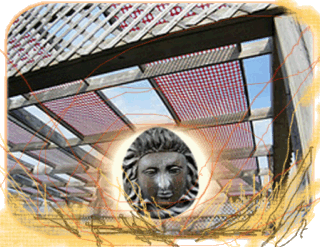 The prospect seems bleak, huh? Autumn leaves have scattered and whisked away over the last week, at least in our area.
Frosted rooves and flowers have been evident, to greet our senses on some of these cooler mornings in October.
The prospect seems bleak, huh? Autumn leaves have scattered and whisked away over the last week, at least in our area.
Frosted rooves and flowers have been evident, to greet our senses on some of these cooler mornings in October.
Fall is one of my very favourite times of the year. Food is abundant, and cheaper, as well as fresher, since harvest may come directly from local farmers and producers.
For me,as a long term gardener, it is always refreshing to visit the local nursery sales areas, though usually in the spring.
This autumn, we chose to take the car out past corn fields and farmlands, beside pretty, tranquil river spaces and toward those dazzling displays of red, gold and orange that crisp up all the more perfectly out in the real country.
Half an hour into the country we stopped at a large nursery garden, sporting enormous carts of brilliant pumpkins. Cameras at ready, we were rewarded with the originality and humour of some rustic crafts near the pumpkins, and then we were able to stroll on several acres of land constituting the business end of the local nursery.
What impressed me, beside the hay "marshmallow" bale dressed up as a turkey, was that there were over a hundred blooming florals ready to plant so late in the season. Gardening does not stop in October, neither is the experience of ones' familiar beds solely for the planting of bulbs for the spring to come.
In the partially sheltered area for outdoor perennials, I found fantastic blooms, for instance, I have always wondered where I could sneak a Red Cardinal Lobelia from. Horticultural societies tell you to leave plants that are in the wild; leave them for the animals and to suit the ecology, don't tamper with nature. Red Cardinal can often be found growing in marsh next to rivers and streams, so I would be loathe to uproot potential disasters for my garden, consisting of snail or leech eggs, among others. I do not need leeches and crayfish crawling all over my flowers, no , thank you!
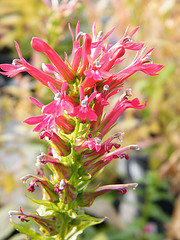 The Red Cardinal Lobelia looked as if it were slightly cultivated, since it had a denser cluster of flowers at the top of the stalk. The colour was not the true crimson of the riverside Red Cardinal, but this was very late in the season. I had found my wild versions in the heat of July, and here it was, October. The plant was still in bloom.
The Red Cardinal Lobelia looked as if it were slightly cultivated, since it had a denser cluster of flowers at the top of the stalk. The colour was not the true crimson of the riverside Red Cardinal, but this was very late in the season. I had found my wild versions in the heat of July, and here it was, October. The plant was still in bloom.
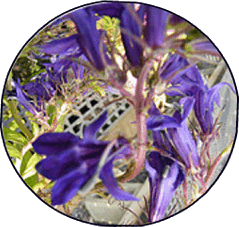 Strolling about, I found a purple version of Beardtongue (Penstemmon) which has become one of my favourites since mine is a cousin to a medicinal folk remedy and also grows three feet high stems full of silken brilliant red blossoms.
Strolling about, I found a purple version of Beardtongue (Penstemmon) which has become one of my favourites since mine is a cousin to a medicinal folk remedy and also grows three feet high stems full of silken brilliant red blossoms.
This summer I had bought a bluebell shade of Penstemmon, but it sat in its perfect soil and did little beside finish ringing its stem of giant blue bells. Of course, it is still alive, but it had better make more stems next year.
I had hoped to show my brilliant blue bells next to my glossy red bells, but not this year. I found that if I wrapped my Red Beardtongue with burlap around this time of year (even if it still in full bloom, which it is) the leaves come back up from the base of the plant in the next year.
Red Beardtongue is called a "Tender perennial", or good luck trying to keep the plant alive 'til next year in this frozen wasteland, Ontario in the winter, unless you use a foam cloche or burlap!
I had good fortune with this plant, and there were four other factors which enhanced the plants' strength and longer life.
1. Natural Protection: It was planted in full sun and also backed by a thick cedar hedge.
2. Root Protection: I poured at least four inches of cedar mulch around all of my plants' roots on that side bed.
3. Self-Recognition: Since I wrapped the plant up in burlap when it was still awake and not frost bitten, its blooms and leaves had a chance to enjoy a blanketed, snuggly existence until it just fell to sleep for the winter months. You can leave the whole stems upon some plants; they will leaf directly from the dead stems all over again.
These are shrubby, woody plants, like Lavender, or Sage. I really believe that some plants want to understand themselves during a full 365 day cycle of existence, and that not cutting it all away might be the answer for the endurance of some species.
4. Zero Scaping: The side bed was treated to minimalist watering and organic fertilizing, like topsoil or cedar leaf mulch. The plant had sun, soil and rainfall to protect it and to strengthen its' genus.
5. Extra: It was also wadded into massive snowfall, to a depth that staggered Ontario last year.
I am moving my Blue Beardtongue out of its peat moss and rich soil heaven into that front bed, where it will have something to bite. Perhaps we may even see this plant adapted to the wild, some years hence!
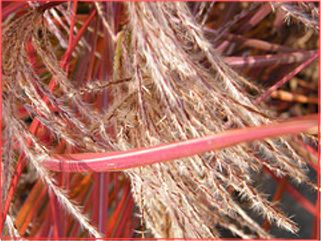 Back to the nursery. There were brilliant white Anenomes and Huuuuuge white Delphiniums for fall plantings. The usual Shining yellow hybrid Black Eyed Susans were there, but there were varieties of plant that I had never seen before.
Back to the nursery. There were brilliant white Anenomes and Huuuuuge white Delphiniums for fall plantings. The usual Shining yellow hybrid Black Eyed Susans were there, but there were varieties of plant that I had never seen before.
A gardener can choose to bed down succulents, ornamental grasses, water plants (the nursery had a small waterfall and rockery) - in fact, all kinds of plant that is cool weather hardy and very attractive in the later months of the year.
Behind these attractive tables full of perennials, long and enormous greenhouses had doors opened to the wonderful warmth of that Thanksgiving Day, and their tables were all full of developing poinsettias. I made a mental note to bother my husband for one more trip on a later weekend. My gardeners' desire for greenery and freshness would not quit for the winter. We were definitely to drive back there to witness the thousands of Christmas Poinsettias and their various hybrid colours!
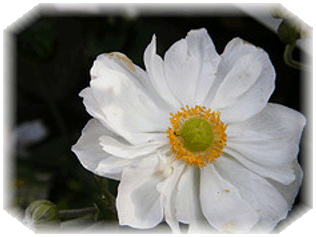 There is always some wonderful event for photographers, and miles of crimson, pink and white flowers are dazzling in the winter months. Not only the feast for tired eyes, the flowers will be a triumph for gardeners - a testimonial to the concept that growing plants can be possible 365 days of the year. Hope, when there is no hope. Life, when all of life has ceased.
There is always some wonderful event for photographers, and miles of crimson, pink and white flowers are dazzling in the winter months. Not only the feast for tired eyes, the flowers will be a triumph for gardeners - a testimonial to the concept that growing plants can be possible 365 days of the year. Hope, when there is no hope. Life, when all of life has ceased.
I loved the architectual look of the shelters and greenhouses; observing flowers under these gave a sort of natural Sukkoth effect.
The Sukkoth is a temporary shelter, traditionally made of staves of wood with just branches roughly lidding the ceiling. It is open in places to the sky. During the Jewish festival of Sukkoth, people in warmer and safer climates can sleep and live under the stars (for a day to a week). It is a time to rejoice, and to pray for the goodness of nature to be well-watered by rain or dew. It is also a time to party. What else is there to do, when camping out?
 When I walked back past the florals, I noticed row after row of planted trees, so many types. One of the planters held a lovely type of soft conifer. Upon the square, wooden planter someone had left one Indian Corn, a natural bow which made a gentle festive statement.
When I walked back past the florals, I noticed row after row of planted trees, so many types. One of the planters held a lovely type of soft conifer. Upon the square, wooden planter someone had left one Indian Corn, a natural bow which made a gentle festive statement.
I did not need much more to amuse my joyous state of mind! Along the nursery roadside there were many trees full of glowing red, maroon or yellow berries, and tiny acid-green crabapples, too. Opposite the nursery dry corn stalks rippled away, gold in the brilliant sunlight.
Before leaving, I took photos of the relevant Hallowe'en decos, and some of the amazing large planters and statues for sale. I noticed that the nursery had a full Christmas shop and also a bulb and packaged plant depot, where I payed (royally) for two of their deluxe (inspected) pumpkins.
If you want to see the area on the Internet (Richmond Nursery, close to Kanata) I have over a hundred photos of what a good nursery should look like.
Link here to Flick.com (Nursery photos)
Even if you live in an apartment building, stopping by one of these places summer or winter will be rewarding, a natural medicine for the senses.
Cheers!...Sue.